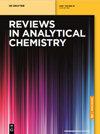Green novel photometric and planar chromatographic assays of remdesivir: Comparative greenness assessment study using estimated GAPI tool versus ISO technical reported methods
IF 3.8
3区 化学
Q2 CHEMISTRY, ANALYTICAL
引用次数: 0
Abstract
Abstract Green assessment of analytical procedures has become an environmental obligation in equivalence to their International Council of Harmonization analytical validation obligation. Worldwide awareness of our planet and ecological hazards have raised the shades of green and sustainable chemistry in pure or formulated API assays. The Green Analytical Procedure Index (GAPI) is instant five pentagrams for evaluating the greenness of each step in the developed analytical procedure, in discriminative colors: green, yellow, and red. In the present study, GAPI is applied to assess three novel direct analytical methods: spectrophotometric, fluorimetric, and high-performance thin-layer chromatography (HPTLC) for remdesivir (RDV) quantitation, both in bulk and pharmaceutical vials. Furthermore, a comparative green level calculated GAPI study has been assembled for the proposed methods versus the previously reported methods, for RDV assay, of similar techniques. Spectrophotometric direct A max method at 240 nm, fluorimetric emission at 404 nm upon excitation at 275 nm as well as the HPTLC densitometric measurement using ethanol and distilled water (7:3, v/v) as mobile phase, all three methodologies are developed, optimized, and fully validated for RDV quantitation. They have been applied to assay RDV pharmaceutical vials and results are compared together with a one-way ANOVA test. Satisfactory recoveries and nano-level sensitivities in addition to the least standard deviations encourage the use of developed methods for routine analysis in quality control laboratories. Their promising greenness profile satisfies the beliefs of ecological sustainability of Green Agenda 2030.瑞德西韦的绿色新型光度法和平面色谱法测定:使用估计的GAPI工具与ISO技术报告方法的绿色评估比较研究
分析方法的绿色评价已成为一项环境义务,与国际协调委员会的分析验证义务相当。全世界对我们的星球和生态危害的认识已经提高了纯或配方API分析中绿色和可持续化学的色调。绿色分析程序指数(GAPI)是即时的五个五角星,用于评估开发的分析程序中每个步骤的绿色程度,有区别的颜色:绿色,黄色和红色。在本研究中,GAPI应用于评估三种新的直接分析方法:分光光度法、荧光法和高效薄层色谱法(HPTLC),用于散装和小瓶瑞德西韦(RDV)的定量。此外,对所提出的方法与先前报道的类似技术的RDV测定方法进行了比较绿色水平计算的GAPI研究。分光光度法直接A法在240 nm,荧光发射在404 nm,激发在275 nm,以及以乙醇和蒸馏水(7:3,v/v)为流动相的HPTLC密度测定,这三种方法都被开发,优化,并充分验证了RDV的定量。它们已应用于测定RDV药瓶,并将结果与单因素方差分析(ANOVA)检验一起进行比较。令人满意的回收率和纳米级灵敏度以及最小的标准偏差鼓励在质量控制实验室中使用开发的常规分析方法。它们的绿色形象符合2030年绿色议程的生态可持续性信念。
本文章由计算机程序翻译,如有差异,请以英文原文为准。
求助全文
约1分钟内获得全文
求助全文
来源期刊

Reviews in Analytical Chemistry
化学-分析化学
CiteScore
7.50
自引率
0.00%
发文量
15
审稿时长
>12 weeks
期刊介绍:
Reviews in Analytical Chemistry publishes authoritative reviews by leading experts in the dynamic field of chemical analysis. The subjects can encompass all branches of modern analytical chemistry such as spectroscopy, chromatography, mass spectrometry, electrochemistry and trace analysis and their applications to areas such as environmental control, pharmaceutical industry, automation and other relevant areas. Review articles bring the expert up to date in a concise manner and provide researchers an overview of new techniques and methods.
 求助内容:
求助内容: 应助结果提醒方式:
应助结果提醒方式:


